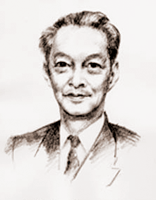What’s he trying to say?
 |
| Shin’ichiro Tomanaga got a Nobel Prize (along with Richard Feynman and Julian Schwinger) for showing how to solve the most difficult equations of quantum mechanics. |
Again Schrieffer can describe what happened only by dropping into the technical language of physics. But we don’t need to understand every word* to get a feeling for how he was thinking. As he tells it, Schrieffer was rummaging through a tool kit that he kept in his head, a bunch of mathematical techniques and special ways of thinking. As a student he had learned how to apply these tricks to all sorts of physics problems. At the same time, he was trying to imagine how actual electrons might push each other around within the superconductor. His moment of discovery came when one particular set of abstract mathematical tools clicked with his vision of the physics of the electrons
*(In case you were wondering — the “Tomonaga wave function” is one way to describe in mathemtics how electrons behave in the strange world of the quantum, a “variational scheme” is a technique for solving equations for particular types of problems, and H is shorthand for the Hamiltonian, that is, the energy in Tomanaga’s equations.)